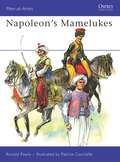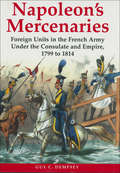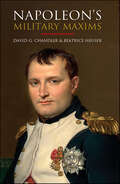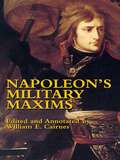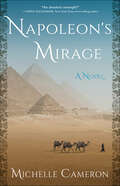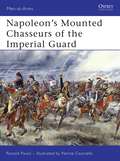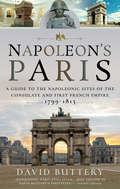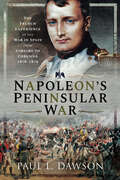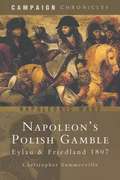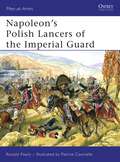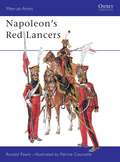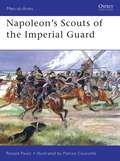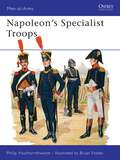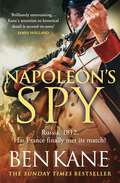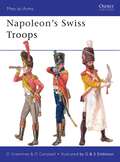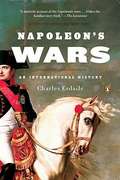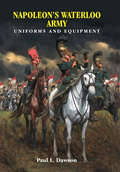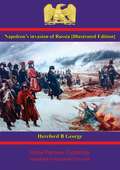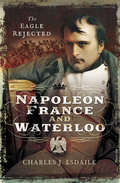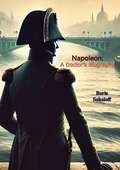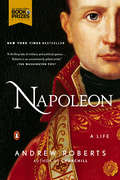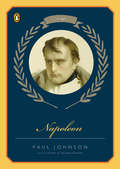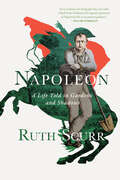- Table View
- List View
Napoleon's Mamelukes
by Patrice Courcelle Ronald PawlyThe most exotic of all the troops of Napoleon's Imperial Guard were undoubtedly the Mamelukes - the bodyguard of Oriental cavalry which followed him home after the Egyptian expedition of 1798-1801, and remained with his Mounted Chasseurs regiment throughout the First Empire. For the first time in English, this book tells the Mamelukes' story, from Austerlitz (1805) to Waterloo (1815). Quoting from the original nominal rolls and battle casualty returns, the author brings individual members of this extraordinary unit to life. His text is illustrated with rare early engravings and paintings, and the full-colour plates show the development of the unit's romantic Turkish uniforms.
Napoleon's Mercenaries: Foreign Units in the French Army Under the Consulate and Empire, 1799 to 1814 (Napoleonic Library)
by Guy DempseyThis superb and comprehensive book details the foreign units which formed such an important part of Napoleon's forces. It examines each non-French unit in turn, giving an overview of the unit's origins, its organizational and combat history, its uniforms and standards, and details of the unit's eventual fate. Colourful accounts, taken from contemporary reports and memoirs, emphasize the qualities of the unit and throw light on what life was like for many of the foreign soldiers recruited into the Grande Armée. In total more than 100 different foreign units that served in the French Army are investigated in detail in this ambitious publication. Some foreign units fought and flourished throughout the Consulate and Empire, whilst others lasted for just a few months. Covers Polish, German, Swiss, Italian, Spanish, and other units in the French Army and presents a combat history and details uniforms for each regiment. Napoleon's Mercenaries is the best single-volume study of this aspect of Napoleon s army and a vital reference for every Napoleonic enthusiast. Little can be found on the foreign units that were an integral part of the French army ... For a long time a gap has existed, but now Napoleon s Mercenaries fills this gap. Robert Burnham, Napoleonic Series
Napoleon's Military Maxims
by David G. Chandler Beatrice Heuser Napoléon BonaparteThis classic work is a distillation of the knowledge, intuition and wisdom of one of history’s greatest military commanders. Napoleon’s success was built upon practical experience combined with his own study of classical warfare and his natural grasp of the key principles of war. His thoughts and theories on the art of waging war are presented here in the form of accessible and readable maxims. This edition also features additional contextual commentary by historians David Chandler and Beatrice Heuser, which allows modern readers to compare Napoleon’s principles with the experience of war today.
Napoleon's Military Maxims
by Napoleon Bonaparte William E. Cairnes George C. D'AguilarThis classic brings together a rich sampling of the knowledge and wisdom of one of history's greatest military commanders. The concise text not only provides a fascinating glimpse of the French leader's intellectual ability for conducting military operations but also reveals his thoughts, theories, and commentaries on waging war and the art of conducting statecraft. Equally relevant to today's entrepreneur, the book is packed with maneuvers that can be applied just as easily to increasing revenues on the battlefield of commerce.
Napoleon's Mirage: A Novel
by Michelle CameronReaders of Stephanie Drey and Allison Pataki will enjoy this highly anticipated sequel, an epic saga of love set during the Napoleonic invasion of Egypt that explores loyalty, cultural failures, and a potentially history-altering military defeat.More than a year has elapsed since the ghetto gates were destroyed and Ancona’s Jewish community liberated by Napoleon’s troops. Yet Mirelle is ostracized—by the community, her erstwhile best friend, and even her mother—and labeled a “ruined woman.” As her efforts to nurture her family’s legacy are thwarted, she realizes she might have lost her last chance at love. Meanwhile, Daniel, now a lieutenant in the French army, and Christophe, the man responsible for Mirelle’s disgrace, set sail to an unknown destination with General Bonaparte’s forces. There, Napoleon and his men face a harsh and unforgiving landscape and new, implacable enemies, and Daniel’s faith in and loyalty to the commander he once worshiped are put to the test. Epic and rich with well-researched detail, Napoleon’s Mirage is a novel of misguided ambition leading to brutal warfare, failures of cultural appropriation, and a military defeat that just may have changed the course of history.
Napoleon's Mounted Chasseurs of the Imperial Guard
by Patrice Courcelle Ronald PawlyA concise history of the hand-picked elite cavalry guard that served as Napoleon's close personal escort and were committed to the most dangerous areas of combat on the battlefield. Formed from his original escort of "Guides" and the "Consular Guard" in 1799, the Mounted Chasseurs were a personal favourite of the Emperor, who wore their uniform on campaign. Ronald Pawly's unique research into regimental archives has uncovered unprecedented detail about this exceptional unit and its soldiers and officers. With their colorful uniforms recreated in full-color artwork and accounts of their actions in the most critical battles of the Napoleonic Wars (1799-1815), this book provides a comprehensive description of a legendary elite.
Napoleon's Paris: A Guide to the Napoleonic Sites of the Consulate and First French Empire 1799–1815
by David ButteryA specialist in Napoleonic history reveals the legendary leader’s influence on the City of Light in this illustrated visitor’s guide.Historian David Buttery explores the many connections between Napoleon and Paris, where many remarkable buildings and monuments date from his time in power. Many of the city’s most famous sites were built or enhanced on Napoleon’s instructions, while others are closely associated with him and the First French Empire.Buttery explores the Napoleonic history of the Arc de Triomphe, the Louvre, the Hôtel des Invalides, Musée de l’Armée, Notre Dame Cathedral, Père-Lachaise Cemetery, and other fascinating sites. Full of evocative detail and practical information, Napoleon’s Paris is essential reading for every history buff who visits the French capital.
Napoleon's Peninsular War: The French Experience of the War in Spain from Vimeiro to Corunna, 1808–1809
by Paul L DawsonA renowned historian captures the French experience of the Peninsular War through soldiers’ unpublished memoirs and eyewitness accounts.While much has been written about the British campaigns of the Peninsular War, surprisingly little has been published in English on their opponents, the French. Now, using previously unseen material from the French army archives in Paris, Paul Dawson tells the story of the early years of the Peninsular War as never before.Eyewitness accounts of the Siege of Zaragoza and the Spanish defeats at Medellin and Ocaña are interspersed with details of campaign life and of struggling through the Galician mountains in pursuit of the British army. Dawson captures the perspectives of ordinary French soldiers and their beliefs about the war they were fighting for their Emperor. Napoleon’s Peninsular War is a vital and unprecedented addition to our understanding of the war in Iberia.
Napoleon's Polish Gamble: Eylau & Friedland 1807 (Campaign Chronicles)
by Christopher SummervilleNapoleon's 1807 campaign against the Russians came close to being his first defeat. At Eylau the Emperor was outnumbered by the army of the Russian commander Bennigsen, yet he accepted battle. His reputation was saved by the flamboyant Murat, who led one of the greatest cavalry charges in history. Christopher Summerville's gripping account of this bitterly fought clash and of Napoleon's subsequent triumph at Friedland is the first extensive study of the campaign to be published for a century. The story is told in the concise, clear Campaign Chronicles format which records the action in vivid detail, day by day, hour by hour. Included are full orders of battle showing the chain of command and the fighting capabilities of the opposing armies.
Napoleon's Polish Lancers of the Imperial Guard
by Patrice Courcelle Ronald PawlyNapoleon's Polish Lancers of the Guard were unique in their appearance and in their loyalty. This book reveals their varied and colorful uniforms as well as their long and loyal service for the Bonaparte cause during the Napoleonic Wars (1799-1815). The Poles were the only foreign contingent never to defect from Napoleon's cause, staying faithful to the end - a squadron even accompanied Napoleon into exile on Elba, and the Guard reformed in 1815 to charge at Waterloo. In 1808, when Napoleon was smashing his way through the Spanish armies to get at British forces in the Peninsular, the Poles astounded observers with their extreme acts of courage and military daring. In one memorable instance the Poles captured a defended mountain pass at Somosierra, overrunning four batteries of cannons in the process. It was they who introduced the use of the lance to the French army, adding a new tactical dimension to the use of the cavalry on the battlefield and demonstrated its deadly effects in all of Napoleon's most famous victories - particularly Wagram in 1809. Brave and ruthless in equal measures, this is a fascinating insight into the fighting lives of the legendary Polish Lancers.
Napoleon's Red Lancers
by Patrice Courcelle Ronald PawlyThe legendary Dutch 'Red' Lancers - the 2nd Light Horse Lancers of Napoleon's Imperial Guard - were formed in 1810, during the Napoleonic Wars (1799-1815), after the emperor annexed Holland and its army to France. The former hussars of the Dutch Royal Guard got a handsome new uniform, a new weapon, and a hard-driving new colonel in Baron Edouard Colbert. His lancers distinguished themselves in Russia in 1812, at huge cost; in Germany in 1813, and in the Low Countries in 1814. When Napoleon returned from exile in 1815 the Red Lancers were with him until night fell over Waterloo. Ronald Pawly is the world's leading expert on the archival and pictorial record left by this regiment; his detailed text is illustrated with rare portraits and photographs, and eight glowing colour plates of a surprisingly wide variety of uniforms.
Napoleon's Scouts of the Imperial Guard
by Patrice Courcelle Ronald PawlyDriven out of Germany after his defeat at Leipzig in 1813, Napoleon seemed to face disaster. Some 345,000 Allied troops were converging on France from the east; and Napoleon had only about 80,000 men. Most of his veterans had been killed in Russia and Germany, and he was short of cavalry to counter the swarms of Cossacks. For his last and possibly most brilliant campaign, Napoleon raised three regiments of mounted Scouts for his Imperial Guard. Through the story of these units the reader can follow Napoleon's dazzling manoeuvres in the campaign of 1814; and their widely varied uniforms are reconstructed in meticulously researched colour plates.
Napoleon's Specialist Troops
by Bryan Fosten Philip HaythornthwaiteThough less celebrated than the infantry and cavalry, Napoleon's 'specialist' troops - artillery, engineers and supporting services - were indispensable elements without which no army could have operated, and frequently assumed greater significance than the line regiments. Indeed, having suffered least from the emigration of Royalist officers, the artillery was the best element of the early Republican armies, the nucleus of the old Royal artillery serving with distinction in the early campaigns such as Valmy. The organisation and uniform of Napoleon's specialist troops are here examined by Philip Haythornwaite in a engaging volume complemented by a wealth of illustrations including eight full page colour plates by Bryan Fosten.
Napoleon's Spy: The brand new epic historical adventure from Sunday Times bestseller Ben Kane
by Ben Kane'Napoleon's Spy is a tour de force on an epic scale' Douglas Jackson 'Exciting, immersive, well researched and great fun.' Giles KristianRussia, 1812. Has France finally met its match?On the eve of the invasion of Russia, half-French, half-English Matthieu Carrey finds himself in the ranks of Napoleon's five hundred thousand strong army. With Tsar Alexander seemingly ill-prepared, a French victory seems certain. The Grande Armée will obliterate everything in its path. Carrey's purpose is less clear. Blackmailed into becoming a spy in the emperor's army, he hopes to follow his lover, a French actress who has gone to work in the Moscow theatre. As supplies grow scarce and temperatures plummet, the Grande Armée begins to crumble. Caught up in the maelstrom of war, Carrey embarks on an epic journey, while the Russians circle like hungry wolves. Hundreds of miles lie between Carrey and safety. To reach it seems utterly impossible.
Napoleon's Spy: The brand new epic historical adventure from Sunday Times bestseller Ben Kane
by Ben Kane'Napoleon's Spy is a tour de force on an epic scale' Douglas Jackson 'Exciting, immersive, well researched and great fun.' Giles KristianRussia, 1812. Has France finally met its match?On the eve of the invasion of Russia, half-French, half-English Matthieu Carrey finds himself in the ranks of Napoleon's five hundred thousand strong army. With Tsar Alexander seemingly ill-prepared, a French victory seems certain. The Grande Armée will obliterate everything in its path. Carrey's purpose is less clear. Blackmailed into becoming a spy in the emperor's army, he hopes to follow his lover, a French actress who has gone to work in the Moscow theatre. As supplies grow scarce and temperatures plummet, the Grande Armée begins to crumble. Caught up in the maelstrom of war, Carrey embarks on an epic journey, while the Russians circle like hungry wolves. Hundreds of miles lie between Carrey and safety. To reach it seems utterly impossible.
Napoleon's Swiss Troops
by Gerry Embleton David GreentreeEver since the 15th century Switzerland had been exporting professional soldiers to serve as mercenaries for foreign monarchies. Napoleon, therefore, was not the first to make full use of the martial qualities of the Swiss and obtained Swiss agreement to expand the recruitment of regiments for service in the French Army. Napoleon would use Swiss troops on the battlefields of Italy and Spain, and in 1812 re-organize the four original regiments into a single division for the invasion of Russia, with each regiment having three full-strength battalions. In all theatres where they were engaged, Swiss contingents would often be relied upon to act as rearguards so other forces caught in a tight situation could escape. Time and again they would be asked to save the day for the French soldiers with whom they fought, in Italy and Spain and most famously for Napoleon himself, in Russia. In November of 1812, meeting up with Napoleon's main force retreating from Moscow at the Berezina River, the Swiss on the west bank guarded the approaches to the pontoon bridges from the Russian attack to the south. 1,200 Swiss, out of approximately 8,000 that entered Russia, were left to face, along with 8,000 men from other units, the 30,000-strong Russian army. The Swiss held their ground and when their ammunition ran out they charged the Russians with bayonets. This book reveals the proud combat history of the Swiss troops of Napoleon's army as well as the colourful uniforms they wore.
Napoleon's Wars: An International History
by Charles EsdaileA glorious?and conclusive?chronicle of the wars waged by one of the most polarizing figures in military historyAcclaimed on both sides of the Atlantic as a new standard on the subject, this sweeping, boldly written history of the Napoleonic era reveals its central protagonist as a man driven by an insatiable desire for fame, and determined ?to push matters to extremes.? More than a myth-busting portrait of Napoleon, however, it offers a panoramic view of the armed conflicts that spread so quickly out of revolutionary France to countries as remote as Sweden and Egypt. As it expertly moves through conflicts from Russia to Spain, Napoleon?s Wars proves to be history writing equal to its subject?grand and ambitious?that will reframe the way this tumultuous era is understood.
Napoleon's Waterloo Army: Uniforms and Equipment
by Paul L. DawsonThe author of Waterloo: The Truth at Last &“sheds new light on the campaign of 1815 and surely will satisfy all with an interest in the Napoleonic Era&” (The Napoleonic Historical Society Newsletter). When Napoleon returned to Paris after exile on the Island of Elba, he appealed to the European heads of state to be allowed to rule France in peace. His appeal was rejected and the Emperor of the French knew he would have to fight to keep his throne. In just eight weeks, Napoleon assembled 128,000 soldiers in the French Army of the North and on 15 June moved into Belgium (then a part of the kingdom of the Netherlands). Before the large Russian and Austrian armies could invade France, Napoleon hoped to defeat two coalition armies, an Anglo-Dutch-Belgian-German force under the Duke of Wellington, and a Prussian army led by Prince von Blücher. He nearly succeeded. Paul Dawson&’s examination of the troops who fought at Ligny, Quatre-Bras and Waterloo, is based on thousands of pages of French archival documents and translations. With hundreds of photographs of original artifacts, supplemented with scores of lavish color illustrations, and dozens of paintings by the renowned military artist Keith Rocco, Napoleon&’s Waterloo Army is the most comprehensive, and extensive, study ever made of the French field army of 1815, and its uniforms, arms and equipment. &“Contains many rare and previously unpublished images in the form of full color drawings and photographs of surviving relics. As with the earlier volumes, this book will appeal to and be enjoyed by a wide readership with special interest for historians, military history enthusiasts, Napoleonic War enthusiasts and re-enactors.&” —Firetrench
Napoleon's invasion of Russia [Illustrated Edition]
by Hereford B. GeorgeNapoleon's invasion of Russia remains the benchmark for military disaster, even some two hundred year after he and his 600,000 men crossed the Niemen into the interior of Russia. The story of these men and their stolid, valiant opponents, the Russians, is recounted in admirable detail by the Author: from the killing fields of Smolensk and Borodino to the great fire of Moscow and the retreat through the snows of the Russian winter. Illustrated with 8 plans, the action of the great struggle is brought into full life, even through the passage of so much time.Author -- George, Hereford B. 1838-1910.Text taken, whole and complete, from the edition published in London, T.F. Unwin, 1899.Original Page Count - xv, 451 p.Illustrations -- 8 maps and plans.
Napoleon, France and Waterloo: The Eagle Rejected
by Charles EsdaileSo great is the weight of reading on the subject of the Waterloo campaign that it might be thought there is nothing left to say about it, and from the military viewpoint, this is very much the case. But one critical aspect of the story has gone all but untold the French home front. Little has been written about the topic in English, and few works on Napoleon or Revolutionary and Napoleonic France pay it much attention. It is this conspicuous gap in the literature that Charles Esdaile explores in this erudite and absorbing study. Drawing on the vivid, revealing material that is available in the French archives, in the writings of soldiers who fought in France in 1814 and 1815 and in the memoirs of civilians who witnessed the fall of Napoleon or the Hundred Days, he gives us a fascinating new insight into the military and domestic context of the Waterloo campaign, the Napoleonic legend and the wider situation across Europe.
Napoleon: A Doctor's Biography
by Boris SokoloffExplore the life of one of history’s most enigmatic and influential figures through a unique medical lens with Boris Sokoloff's "Napoleon: A Doctor's Biography." This captivating biography offers a fresh perspective on Napoleon Bonaparte, blending historical analysis with medical insights to provide a comprehensive and nuanced portrait of the legendary leader.Boris Sokoloff, a distinguished physician and historian, meticulously examines Napoleon’s life from a medical standpoint, shedding light on how health issues influenced his decisions, behavior, and ultimately, his destiny. Sokoloff’s dual expertise allows him to delve into the physical and psychological aspects of Napoleon's character, offering readers a deeper understanding of the man behind the myth."Napoleon: A Doctor's Biography" covers the entirety of Napoleon’s life, from his early years in Corsica and his rapid rise to power to his military campaigns and eventual exile. Sokoloff explores how Napoleon’s health—affected by conditions such as epilepsy, stomach ailments, and mental stress—shaped key moments in his career. He also discusses the medical treatments available during Napoleon's time and how they were applied to the Emperor’s ailments.Through detailed analysis and compelling narrative, Sokoloff provides insights into Napoleon’s personal and professional life, including his relationships, leadership style, and the relentless drive that defined his legacy. The book also examines the historical context of Napoleon’s era, giving readers a well-rounded view of the political and social factors that intertwined with his medical history.Rich with historical anecdotes, medical case studies, and vivid descriptions, "Napoleon: A Doctor's Biography" is an essential read for history enthusiasts, medical professionals, and anyone intrigued by the complex interplay between health and historical events. Sokoloff’s engaging writing style makes this scholarly work accessible and intriguing, bringing to life the multifaceted nature of one of history’s most compelling figures. Discover the hidden dimensions of Napoleon Bonaparte’s life and leadership through the eyes of a doctor, and gain a new appreciation for the intricate factors that influenced his remarkable journey.
Napoleon: A Life
by Adam ZamoyskiThe definitive biography of Napoleon, revealing the true man behind the legend"What a novel my life has been!" Napoleon once said of himself. Born into a poor family, the callow young man was, by twenty-six, an army general. Seduced by an older woman, his marriage transformed him into a galvanizing military commander. The Pope crowned him as Emperor of the French when he was only thirty-five. Within a few years, he became the effective master of Europe, his power unparalleled in modern history. His downfall was no less dramatic.The story of Napoleon has been written many times. In some versions, he is a military genius, in others a war-obsessed tyrant. Here, historian Adam Zamoyski cuts through the mythology and explains Napoleon against the background of the European Enlightenment, and what he was himself seeking to achieve. This most famous of men is also the most hidden of men, and Zamoyski dives deeper than any previous biographer to find him. Beautifully written, Napoleon brilliantly sets the man in his European context.
Napoleon: A Life
by Andrew RobertsThe definitive biography of the great soldier-statesman by the New York Times bestselling author of The Storm of War--winner of the Los Angeles Times Book Prize for Biography and the Grand Prix of the Fondation Napoleon Austerlitz, Borodino, Waterloo: his battles are among the greatest in history, but Napoleon Bonaparte was far more than a military genius and astute leader of men. Like George Washington and his own hero Julius Caesar, he was one of the greatest soldier-statesmen of all times. Andrew Roberts's Napoleon is the first one-volume biography to take advantage of the recent publication of Napoleon's thirty-three thousand letters, which radically transform our understanding of his character and motivation. At last we see him as he was: protean multitasker, decisive, surprisingly willing to forgive his enemies and his errant wife Josephine. Like Churchill, he understood the strategic importance of telling his own story, and his memoirs, dictated from exile on St. Helena, became the single bestselling book of the nineteenth century. An award-winning historian, Roberts traveled to fifty-three of Napoleon's sixty battle sites, discovered crucial new documents in archives, and even made the long trip by boat to St. Helena. He is as acute in his understanding of politics as he is of military history. Here at last is a biography worthy of its subject: magisterial, insightful, beautifully written, by one of our foremost historians.From the Hardcover edition.
Napoleon: A Life
by Paul JohnsonFrom New York Times bestselling author Paul Johnson, "a very readable and entertaining biography" (The Washington Post) about one of the most important figures in modern European history: Napoleon Bonaparte In an ideal pairing of author and subject, the magisterial historian Paul Johnson offers a vivid look at the life of the strategist, general, and dictator who conquered much of Europe. Following Napoleon from the barren island of Corsica to his early training in Paris, from his meteoric victories and military dictatorship to his exile and death, Johnson examines the origins of his ferocious ambition. In Napoleon's quest for power, Johnson sees a realist unfettered by patriotism or ideology. And he recognizes Bonaparte's violent legacy in the totalitarian regimes of the twentieth century. Napoleon is a magnificent work that bears witness to one individual's ability to work his will on history.
Napoleon: A Life Told In Gardens And Shadows
by Ruth ScurrMarking the 200th anniversary of his death, Napoleon is an unprecedented portrait of the emperor told through his engagement with the natural world. “How should one envisage this subject? With a great pomp of words, or with simplicity?” —Charlotte Brontë, “The Death of Napoleon” The most celebrated general in history, Napoleon Bonaparte (1769–1821) has for centuries attracted eminent male writers. Since Thomas Carlyle first christened him “our last Great Man,” regiments of biographers have marched across the same territory, weighing campaigns and conflicts, military tactics and power politics. Yet in all this time, no definitive portrait of Napoleon has endured, and a mere handful of women have written his biography—a fact that surely would have pleased him. With Napoleon, Ruth Scurr, one of our most eloquent and original historians, emphatically rejects the shibboleth of the “Great Man” theory of history, instead following the dramatic trajectory of Napoleon’s life through gardens, parks, and forests. As Scurr reveals, gardening was the first and last love of Napoleon, offering him a retreat from the manifold frustrations of war and politics. Gardens were, at the same time, a mirror image to the battlefields on which he fought, discrete settings in which terrain and weather were as important as they were in combat, but for creative rather than destructive purposes. Drawing on a wealth of contemporary and historical scholarship, and taking us from his early days at the military school in Brienne-le-Château through his canny seizure of power and eventual exile, Napoleon frames the general’s story through the green spaces he cultivated. Amid Corsican olive groves, ornate menageries in Paris, and lone garden plots on the island of Saint Helena, Scurr introduces a diverse cast of scientists, architects, family members, and gardeners, all of whom stood in the shadows of Napoleon’s meteoric rise and fall. Building a cumulative panorama, she offers indelible portraits of Augustin Bon Joseph de Robespierre, the younger brother of Maximilien Robespierre, who used his position to advance Napoleon’s career; Marianne Peusol, the fourteen-year-old girl manipulated into a Christmas-Eve assassination attempt on Napoleon that resulted in her death; and Emmanuel, comte de Las Cases, the atlas maker to whom Napoleon dictated his memoirs. As Scurr contends, Napoleon’s dealings with these people offer unusual and unguarded opportunities to see how he grafted a new empire onto the remnants of the ancien régime and the French Revolution. Epic in scale and novelistic in its detail, Napoleon, with stunning illustrations, is a work of revelatory range and depth, revealing the contours of the general’s personality and power as no conventional biography can.
